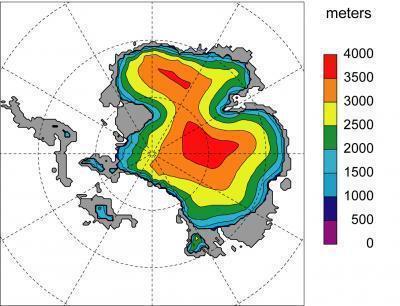Global climate has quickly moved from an almost iceless world to giant ice sheets on Antarctica about 34 million years ago. What happen? What has changed? A group of scientists led by Yale geologists gave a new perspective on the nature of climate conditions in this gas-to-ice transformation - this view rejects previous theories. This is important in predicting future climate change.
Published in Science magazine on February 27, their data completely dismissed the long-held idea that the development of the giant ice sheets in Antarctica accompanied little or no change. changes in global temperatures.
This report shows that before the Southern hemisphere's ice expanded, the high-latitude temperature was at least 10 degrees Celsius (about 18 degrees F) higher than previously predicted and during the climate transfer process, The water surface temperature has decreased from 5-10 degrees C.
According to lead author Mark Pagani, professor of geology and geophysics at Yale, 'Previous reconstruction models do not provide any evidence of a high latitude temperature drop. Our data demonstrate that there is clearly a decrease in temperature in both hemispheres at that time. '
Their conclusion is based on surface temperature - calculating the temperature based on the distribution of some organic molecules identified from plankton, this animal only lives at a certain temperature range and is kept in marine sediments. These molecules are studied by the Ocean Drilling Combine Program (IODP) and previous marine programs studying Earth's history by exploring sediments and shells in deep-sea areas around the world.
 Illustrate the image of the first Antarctic ice sheet when the global climate cooled down about 33.5 million years ago. Antarctica is gray, with an iceberg based on a scale of ice thickness. The ice is the size of a continent, but smaller than it is today. Estimates are based on DeContro and Pollard's model, along with support from new research data. (Photo: DeConto & Pollard / Nature)
Illustrate the image of the first Antarctic ice sheet when the global climate cooled down about 33.5 million years ago. Antarctica is gray, with an iceberg based on a scale of ice thickness. The ice is the size of a continent, but smaller than it is today. Estimates are based on DeContro and Pollard's model, along with support from new research data. (Photo: DeConto & Pollard / Nature)
Main author Zhonghui Liu, a professor at the University of Hong Kong, said: 'The temperature in some areas, before the Antarctic glaciers formed, is much higher than what the climate model does. This predicts that these models have underestimated high latitude warming under high CO2 conditions'. In addition, the gradual cooling of the climate then appears at both the North and South latitudes, indicating a reduction in CO2 concentration rather than a change in sea circulation as the cause of climate change.
Ice formed throughout Antarctica for about 100,000 years , just like the 'overnight' conversion in geological terms. Co-author Matthew Huber of Purdue University said: 'More than 35 million years ago, ice appeared in areas where there was a subtropical climate'.
Another theory that the study rejects is that the concept of ice expansion appears in the Northern Hemisphere at that time - the hypothesis is only supported by evidence of regional glacier formation.
Antarctic ice sheets represent sea level rise of about 70 meters. In addition, there are many questions about glacial stability, the threshold temperature that makes the glacier, and the speed at which it changes. According to Pagani, 'Our findings indicate the difficulty of building accurate temperature models under high CO2 conditions'.
Other authors of the article include David Zinniker of Yale, Robert DeConto and Mark Leckie of Massachusetts University, Amherst, Matthew Huber of Purdue University, Henk Brinkhuis of Utrecht University, and Sunita R. Shah and Ann Pearson of Harvard. . The research was funded by the National Science Foundation and Yale University, calculations based on sources from the Rosen Advanced Informatics Center at Purdue.
 'Fine laughs' - Scary and painful torture in ancient times
'Fine laughs' - Scary and painful torture in ancient times The sequence of numbers 142857 of the Egyptian pyramids is known as the strangest number in the world - Why?
The sequence of numbers 142857 of the Egyptian pyramids is known as the strangest number in the world - Why? History of the iron
History of the iron What is alum?
What is alum?